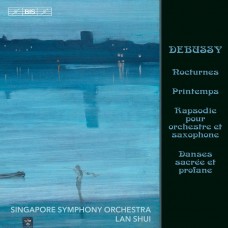|
德布西:春/薩克斯風及管弦樂狂想曲/蘇格蘭進行曲/英雄搖籃曲
水藍 指揮
新加坡交響樂團
在這張錄音專輯中的作品是在德布西一生中不同的時期所寫的並且反映出不同面貌的他: 從一位不確定自己曲風的年輕人到充滿自信的大師, 從一個努力達成有時不一致酬勞工作的職業作曲家, 到一個被疾病與外在事物拖垮的人. 這張專輯一開始的管絃樂曲(春), 原本是德布西在1887年在獲得羅馬大獎(Prix de Rome)並在義大利定居時寫給聲樂, 鋼琴和管絃樂團的作品, 但卻在25年後由布塞爾(Henri Busser)在德布西指導下配器改編後出版. 接下來的有三首是受人委託收取酬勞的作品: 來自一位女薩克斯風手委託的狂想曲, 一位蘇格蘭裔美國將軍委託而寫的(蘇格蘭進行曲)和為樂器製造商Pleyel宣傳一部新的半音階豎琴(Chromatic Harp)而寫的兩首舞曲. 這專輯中按年代來算是最後寫的(英雄搖籃曲)是德布西在一次大戰開始時向比利時國王致敬所貢獻的作品. 他拋棄了在自己安全的家中寫英雄式的進行曲的想法後, 反而選擇鋼琴搖籃曲的寫法. 然後在次年配器成為管弦樂曲. 專輯結尾的作品的(夜曲)是指揮水藍與新加坡交響樂團的德布西三部曲專輯的最後一部, 德布西借用惠斯勒(James Whistler)一系列大氣透視畫作的名稱, 用三個相同氣氛程度的樂章組成, 到今日仍然是管弦樂中最受喜愛的作品之一.
Singapore Symphony Orchestra
Lan Shui conductor
The works on this recording were written at various periods
in Claude Debussy’s life, and reflect different aspects of him:
from a young man stylistically unsure of himself to the
confident maître, from a jobbing composer struggling to
fulfill sometimes incongruous commissions to a man worn
down by illness and outer events. The disc opens with
Printemps – a work originally for choir, piano and orchestra
written in 1887 during Debussy’s stay in Italy as a winner of
the Prix de Rome, but only published 25 years later in an
orchestration made by Henri Büsser under the composer’s
supervision. Three of the works that follow were
commissions – the Rapsodie from a lady saxophonist, the
Marche ecossaise from an American general of Scottish
descent and the Deux Dances from the instrument-maker
Pleyel wanting to market a new model for a chromatic harp.
Chronologically the last work on the programme, Berceuse
heroique is Debussy's contribution to a tribute to the king of
Belgium at the beginning of the Great War. Having rejected
the idea of writing a heroic march in the safety of his own
home he instead opted for a lullaby for piano, which he
orchestrated the following year. The closing work on the
disc, however, is Nocturnes, for which Debussy borrowed the
title from a series of atmospheric paintings by James
Whistler. Made up of three equally atmospheric movements,
it is today one of Debussy’s best-loved compositions for
orchestra. Nocturnes also forms the end of a trilogy of
Debussy albums from the Singapore Symphony Orchestra
and Lan Shui. Critical acclaim for the team range from
‘superb’ (BBC Music Magazine, about La mer) and
‘unquestionably world-class’ (Klassik-Heute.de, about the
orchestra) to ‘a magnificent disc’ – the French magazine
Classica’s verdict on the three ballet scores Jeux, Khamma
and La Boîteà joujoux.
Claude Debussy (1862– 1918)
1–2 ) Printemps , L 68/(61) 16'32
3 ) Rapsodie pour orchestre
et saxophone, L 104/(98) 10'24
Claude Delangle alto saxophone
4 ) Marche ecossaise sur un
thème populaire, L 83/(77) 7'07
5 ) Berceuse heroïque, L 140/(132) 5'38
6–7 ) Deux Danses, L 113/(103) 10'07
Danse sacree · Danse profane
Gulnara Mashurova harp
8–10 ) Nocturnes, L 98/(91) 24'35
The Philharmonic Chamber Choir of Europe
TT: 75'37
|
|



